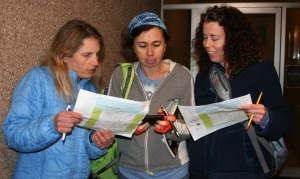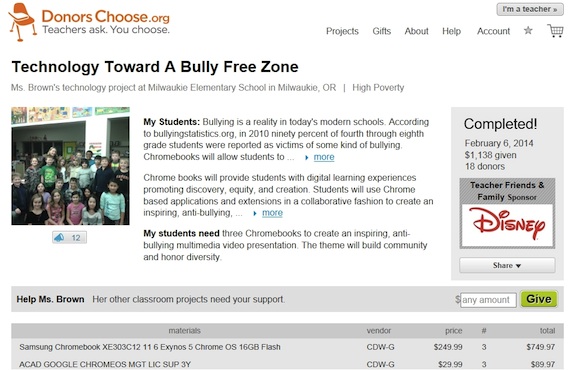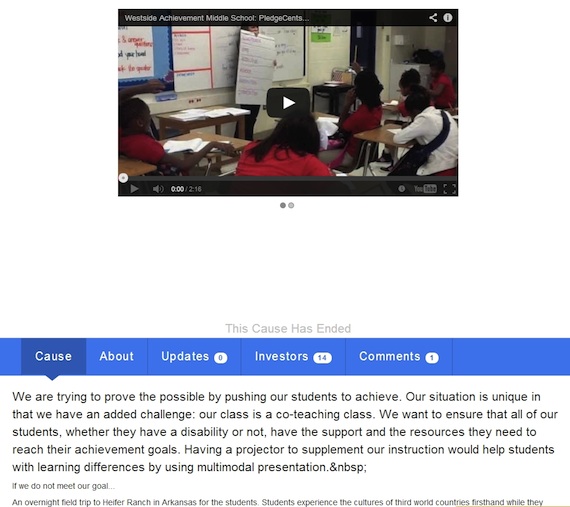3 Ways To Raise Money for Tech in the Classroom
When schools need technology and districts can't provide it, sometimes the only way to find the funds is to get creative.
- By Dian Schaffhauser
- 04/21/14
#ifsherlockhadgoogleglass was off to an early lead with four correct answers at the one hour mark in the Tech Search Party. But when the clock had finally run its course two hours from the moment the scavenger hunt had begun, it was the Immersion Mamas who won the annual fundraising competition. The real winners, however, were the technology programs in three schools in San Francisco that would split the $15,000-plus raised.
The Tech Search Party was one parent's idea for generating the money his kids' schools needed to get their hands on technology. But it's not the only way that people are raising the funds they need to buy new gear and training to add technology into the classroom. A teacher in Oregon used crowdfunding site DonorsChoose to generate some of the funding she needed to bring Chromebooks into her fourth grade; and a seventh grade English teacher in Memphis used PledgeCents, a lesser known crowdfunding site, to raise the money to buy a new classroom projector.
In each case the district couldn't provide the technology budget needed for these acquisitions, so individuals took on the job of doing it themselves. The lesson they've all learned: If they can do it, the rest of us can too.

Participants in the Tech Scavenger Hunt |
$15,000 with a Scavenger Hunt
Pegged as "the world's geekiest scavenger hunt," the Tech Search Party is the brainchild of Tim Smith, a tech publicist who runs Element PR. The Feb. 8 event drew 20-some teams to scramble around the San Francisco neighborhood of Noe Valley, trying to answer a series of clues they're given at the beginning of the race. For example, one clue this year was: "Tarantino and Lundgren Both Have 160." The answer: Both have IQs of 160. The location the team had to find was EyeQ Optometry. Those who figured out the puzzler found a sign confirming that fact at the location; they'd take a picture of the sign with their smart phones and send it to an e-mail address set up for the occasion, monitored by judges (including Smith's wife).
Every now and then throughout the evening, Smith would tweet a hint to contestants ("Einstein is also 160") while holding court from the window seat of the Valley Tavern, a popular bar in the neighborhood.
This is the fifth year the event has taken place, always in the same neighborhood and always with Smith at the helm. He comes up with the locations and clues. He gets permission from the businesses residing at the addresses so they're not surprised when teams of four or six start showing up at their door snapping photos of the exterior. He drums up sponsorships and prizes. And he hands over the money raised to the parent-teacher associations for three beneficiaries, Alvarado Elementary School, James Lick Middle School, and Marshall Elementary School.
By last year the fundraiser had generated a total surpassing $50,000 through a combination of sponsorships and team registration fees of $50 or $75 apiece depending on size.
The schools themselves decide how they're going to spend the funds. This year, Smith said, all of the schools seem to want to spend the money on teacher training and professional development. "The hardware and software infrastructure has been getting better over the years," he noted. Now that they're out of "triage mode," the teachers want to learn how to use technology better in the classroom.
Following the contest, Smith said, he expects that once again he'll hear from other schools and districts that want to put on a similar event, but so far there haven't been many takers. After all, he pointed out, he has an interesting combination of skills, one that combines a career in the tech business with an interest in education technology. Plus, he's close to Silicon Valley, and he's not afraid to hit up companies to see if they'll sponsor the event. He's sent e-mails off to the CEOs of Apple, Salesforce, Google and plenty of other companies large and small in his search for sponsorship dollars and prizes.
Google has become a repeat sponsor; this year also saw support from an after-school enrichment program, a STEM teaching company that uses robots in education, an IT services and design firm, a local bank and a company where parents can find babysitters.
Persistence pays. After months of trying to get sponsorship interest from the Golden State Warriors, the Oakland pro basketball team, and hearing nothing, Smith sent a message off to the CEO, who responded that the event sounded "cool." He CCed somebody else in his response who said the team didn't have any money to do a sponsorship this year but offered tickets instead. So one of the prizes this year is a bundle that includes four tickets to Warriors games for next season, along with four tickets to San Francisco Giants games, and a collection of Xbox 360 games from Ubisoft. Other prizes focus on food and wine, shopping and driving.
Smith's two kids have moved on from the schools that are the beneficiaries, but he continues the effort because, he said, he likes "being an example" for them. "It's not like I can write a check to schools for tens of thousands of dollars, but I can raise some money this way."
$1,000 with DonorsChoose
Milwaukie Elementary School outside of Portland, OR, where Harmony Brown teaches fourth grade, has evolved its integration of technology into the classroom. The school, which has a near-50 percent free-and-reduced-lunch population, has a computer lab with 30 machines and started out with a MacBook cart and an iPad cart. As Brown pointed out, the cart approach wasn't optimal. "You had to sign up for those, go down, get them, plan for it and think about when you wanted to do all that." Gradually, the school came to realize that the technology needed to be more accessible, which meant in the classroom. So the contents of the carts were divvied up, and every teacher ended up with about four Macs and four iPads.
During the summer, Brown took a class on using Chromebooks to teach the Common Core curriculum. That got her excited about introducing Chromebooks into the classroom. When she asked the district to get some for her, she was given the bad news: "There's no money; look at writing grants."
So she took a grant-writing class and learned about the North Clackamas Education Foundation, a non-profit that issues teacher enrichment grants, among its other funding efforts. Since applicants in that process get extra points for finding matching funds from another source, Brown approached the owner of a software development company — somebody in her personal network — who agreed to match whatever the foundation gave her. In that way, Brown raised $2,000, with which she purchased seven Samsung Chromebooks.

By early February, Brown's Chromebook project was fully funded through DonorsChoose. |
The initiative wasn't simply to buy devices; it was to buy devices in order to help the students create videos to teach anti-bullying.
Feeling upbeat about her prospects, Brown decided to go for an even 10 devices by seeking funding through DonorsChoose to buy three more Chromebooks. DonorsChoose is a Web-based service that allows teachers to post their classroom needs and solicit funds from donors to pay for them. If a project doesn't get fully funded, the donors aren't charged (though they're encouraged to apply their pledges to other projects).
As advised in her grant-writing course, Brown studied the other projects that found funding and discovered that 75 percent of the time projects set at around the $800 mark were successful. She set the goal of her project, "Technology Toward a Bully Free Zone," at $1,000.
To promote the fundraising, Brown sent out a series of personal e-mails to friends and families explaining the project and providing statistics on the benefits of technology in working with low-income students. "I would say the bulk of my donations came from that," she says. She also sent out two e-mails apiece to the parents of her students and the officers of the parent-teacher organization. While she also publicized the project on Facebook, she said she doesn't believe she generated "a whole lot of interest" that way, "but you never know."
By early February, the project was fully funded. In fact, there was a bit of extra funding. So aside from making an optional donation to DonorsChoose to support its work, Brown was also able to purchase a three-year license for access to a Web-based management console from Google that allows an administrator to configure, track, and manage the Chromebooks.
$800 with PledgeCents
When Emily Zava went to orientation at Westside Achievement Middle School in Memphis, she and the other teachers were told that although each would receive a laptop, iPad and projector, the projectors "were a gamble." They were so old, she heard, that finding replacement light bulbs could be a real challenge. This was a definite contrast from her previous school, which was packed with "all the bells and whistles of technology."
Sure enough, early on, the projector's bulb gave out, and Zava decided it might be smarter for her to come up with the funding to buy a new projector than to hunt for a "missing light bulb."
Although Zava was a fan of DonorsChoose, which she's used in the past "very successfully," this time around she decided to explore PledgeCents, another education-focused crowdfunding site that launched in 2013 with two Memphis-based fundraising campaigns.
What appealed to Zava was that unlike the more established service, this one gave teachers whatever money was raised toward their project, whether or not it was fully funded. In fact, teachers are asked to post an alternative project as a kind of P.S. In Zava's case that alternate would be a field trip for the kids. If more money were raised than the goal, those additional funds would go to the teacher as well.
DonorsChoose has a system in place by which teachers choose what they want out of a catalog based on how many "points" they've earned. With PledgeCents, Zava explained, "You raise the money, you get the money in a check, and you go out and buy what you need. We raised a little bit more than we had planned, so we bought our projector and we were also able to buy a clicker and some extra paper for the classroom."
It helped, she noted, that co-founder Andyshea Saberioon contacted her personally and suggested that she put up a video on the project profile showing her students. To help her, PledgeCents would even produce the video if she'd provide short clips and photos of students talking about their classroom. "It was amazing. I was impressed," she said. "I would have to say the customer service for PledgeCents is high."

PledgeCents offered to produce a video for Zava's project if she'd provide short clips and photos of students talking about their classroom. |
PledgeCents also included the project in their subscriber newsletter, which generated funding "from people we didn't even know," Zava exclaimed. She and her co-teacher also posted information and fundraising progress reports on Facebook. However, they chose not to send any messages directly to the families of their students.
The project was put up at the end of July last year; by the first week of October it had been fully funded. The Epson projector she purchased with the money has been, she added, "a lifesaver."
What about the field trip? Another teacher in the team went after some funding from Target, and that will allow at least some of the kids in Zava's class to get out of town. "Everyone," she said, "wins in the end on this one."
|
Advice from the Pros
Harmony Brown advised going through DonorsChoose and looking at the projects similar to yours that have drawn the most donors to see what they have in common, then copying those techniques. Don't stop there, however. "Try to think of something to include in your project not included in the others so you can take it a step above what other people who have done a good job have achieved."
Emily Zava recommended that any teacher who wants to add some technology to the classroom should go the route of PledgeCents. "If you're on the fence about it, just do it. You may not raise $800 for the projector you want, but even if you raise $100, you can use that for other supplies. Any amount really impacts the students in the classroom."
Putting on an event like a scavenger hunt, said Tim Smith, requires "a healthy imagination, a sense of fun and community, and the wherewithal to aim really, really high." Plus, it doesn't hurt that he's continually trolling throughout the year for potential clues and historic points of interest that can make the players crazy. "I like messing with people. It's kind of a hobby of mine."
|
About the Author
Dian Schaffhauser is a former senior contributing editor for 1105 Media's education publications THE Journal, Campus Technology and Spaces4Learning.